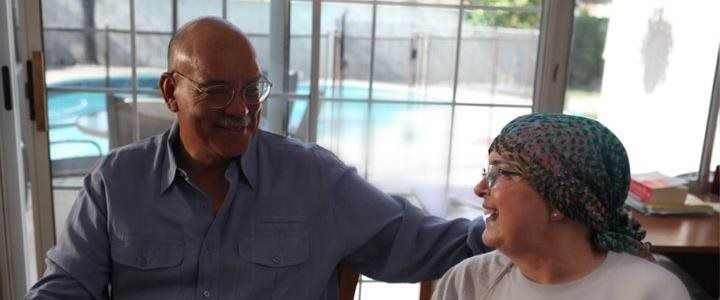(BPT) – Within days of Marcia learning she had cancer, she decided she wanted to live her life without the dark cloud of her diagnosis hanging over her.
“I realized that I was in control of how I lived,” said Marcia.
Marcia was diagnosed with glioblastoma (GBM), a rare but aggressive brain cancer that affects around 12,500 Americans a year. She received her diagnosis at the start of 2015, after experiencing uncontrollable eye movements followed by a seizure.
Surgery took place immediately, which was followed by chemotherapy and radiation. Her family arranged a consultation with two doctors at university cancer centers, who mentioned that there was another treatment now available, called Optune. The therapy is a wearable and portable device that she would use in addition to her current treatments.
“Hearing that there’s something else that’s actually available to us was kind of like a ray of light,” said Marcia. “There wasn’t much question that I wanted to take advantage of something that I could add to my current therapies and had no additional system toxicity.”
Optune creates low-intensity, electric fields called Tumor Treating Fields (TTFields) that may slow or stop cancer cells from dividing, and may cause them to die. These TTFields are delivered by four adhesive patches, called transducer arrays, to the location of a GBM tumor. To wear the transducer arrays, which are connected to the device, the patient must have a shaved scalp.
“I didn’t mind at all having my head shaved,” said Marcia. “The first time it seemed a little strange but I’ve certainly gotten over that now.”
As had been true of Marcia’s treatment to date, her family was there to support her. When Marcia’s dedicated Device Support Specialist (DSS) came to her home to provide an in-person training, Marcia’s husband, along with one of her sisters and daughters, were present.
“It was kind of a fun time just shaving my head and talking about it and it felt like we were doing something very important,” said Marcia. “I felt that what it gives you is so much greater than what it takes away, which is mainly your hair.”
Marcia has remained active, doing crafts including making jewelry, going on short walks with her husband and helping care for her two grandchildren. She appreciates not only being able to spend quality time with her family now, but also all of their support throughout her whole journey.
“My husband, my kids, my sisters, they stopped in their tracks and did anything I needed done,” said Marcia. “My husband was my personal warrior; he went to war for me and I can never thank him enough for that.”
Marcia shows her appreciation for her family’s efforts by continuing her fight against GBM.
“I’ve never thought about stopping the use of the Optune device,” said Marcia. “I know I may have to use the Optune for the rest of my life, but if it means I get a ‘rest of my life,’ then it’s well worth it.”
To learn more about this FDA-approved device, speak with your healthcare provider and visit www.Optune.com.
Indications for Use
Optune® is intended as a treatment for adult patients (22 years of age or older) with histologically-confirmed glioblastoma multiforme (GBM).
Optune with temozolomide is indicated for the treatment of adult patients with newly diagnosed, supratentorial glioblastoma following maximal debulking surgery and completion of radiation therapy together with concomitant standard of care chemotherapy.
For the treatment of recurrent GBM, Optune is indicated following histologically- or radiologically-confirmed recurrence in the supratentorial region of the brain after receiving chemotherapy. The device is intended to be used as a monotherapy, and is intended as an alternative to standard medical therapy for GBM after surgical and radiation options have been exhausted.
Summary of Important Safety Information
Contraindications
Do not use Optune if you have an active implanted medical device, a skull defect (such as, missing bone with no replacement), or bullet fragments. Use of Optune together with implanted electronic devices has not been tested and may theoretically lead to malfunctioning of the implanted device. Use of Optune together with skull defects or bullet fragments has not been tested and may possibly lead to tissue damage or render Optune ineffective.
Do not use Optune if you are known to be sensitive to conductive hydrogels. In this case, skin contact with the gel used with Optune may commonly cause increased redness and itching, and rarely may even lead to severe allergic reactions such as shock and respiratory failure.
Warnings and Precautions
Use Optune only after receiving training from qualified personnel, such as your doctor, a nurse, or other medical personnel who have completed a training course given by Novocure™ (the device manufacturer).
Do not use Optune if you are pregnant, you think you might be pregnant or are trying to get pregnant. It is not known if Optune is safe or effective in these populations.
The most common ( ≥10%) adverse events involving Optune in combination with temozolomide were low blood platelet count, nausea, constipation, vomiting, fatigue, scalp irritation from device use, headache, convulsions, and depression.
The most common ( ≥10%) adverse events seen when using Optune alone were scalp irritation from device use and headache.
The following adverse reactions were considered related to Optune when using the device alone: scalp irritation from device use, headache, malaise, muscle twitching, fall and skin ulcer.
All servicing procedures must be performed by qualified and trained personnel.
Do not use any parts that do not come with the Optune Treatment Kit, or that were not sent to you by the device manufacturer or given to you by your doctor.
Do not wet the device or transducer arrays.
If you have an underlying serious skin condition on the scalp, discuss with your doctor whether this may prevent or temporarily interfere with Optune treatment.

